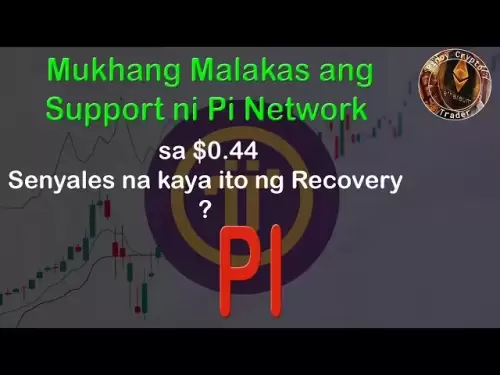-
 Bitcoin
Bitcoin $108,708.8110
0.60% -
 Ethereum
Ethereum $2,561.6057
1.91% -
 Tether USDt
Tether USDt $1.0001
-0.03% -
 XRP
XRP $2.2795
0.57% -
 BNB
BNB $662.2393
1.00% -
 Solana
Solana $153.1346
3.74% -
 USDC
USDC $1.0000
0.00% -
 TRON
TRON $0.2877
0.97% -
 Dogecoin
Dogecoin $0.1710
3.93% -
 Cardano
Cardano $0.5871
1.61% -
 Hyperliquid
Hyperliquid $39.6663
1.68% -
 Sui
Sui $2.9032
0.79% -
 Bitcoin Cash
Bitcoin Cash $496.1879
1.71% -
 Chainlink
Chainlink $13.5807
3.01% -
 UNUS SED LEO
UNUS SED LEO $9.0777
0.61% -
 Stellar
Stellar $0.2514
4.51% -
 Avalanche
Avalanche $18.1761
1.86% -
 Shiba Inu
Shiba Inu $0.0...01173
1.72% -
 Toncoin
Toncoin $2.8010
-4.23% -
 Hedera
Hedera $0.1594
3.21% -
 Litecoin
Litecoin $87.0257
-0.53% -
 Monero
Monero $319.1217
1.79% -
 Polkadot
Polkadot $3.3853
0.68% -
 Dai
Dai $0.9999
-0.01% -
 Ethena USDe
Ethena USDe $1.0003
0.02% -
 Bitget Token
Bitget Token $4.3420
-0.97% -
 Uniswap
Uniswap $7.3772
1.39% -
 Aave
Aave $286.6277
5.61% -
 Pepe
Pepe $0.0...09994
2.33% -
 Pi
Pi $0.4589
1.76%
How to track the changes in UNI whale addresses?
Tracking UNI whale addresses with tools like Etherscan and Nansen helps analyze market trends and potential price impacts based on large holders' transactions.
Apr 25, 2025 at 07:01 am
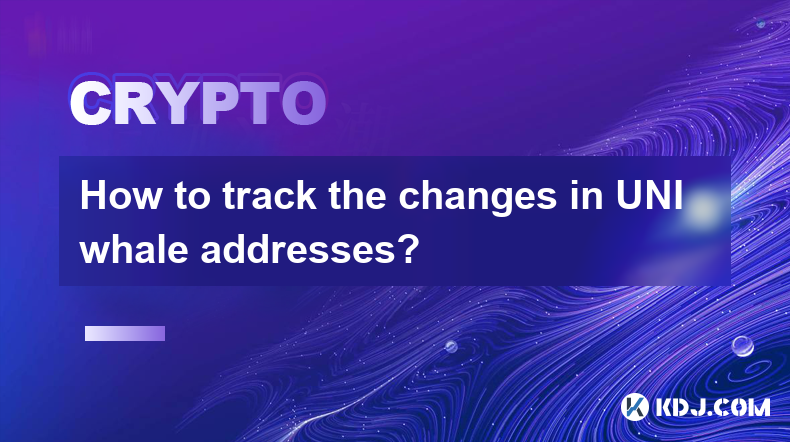
Tracking changes in UNI whale addresses can provide valuable insights into the movements and potential market impacts of large holders of Uniswap's native token, UNI. This process involves monitoring the blockchain for significant transactions, analyzing the data, and using tools to visualize and interpret the information. Below, we will explore the detailed steps and tools needed to effectively track UNI whale addresses.
Understanding Whale Addresses
Whale addresses are those that hold a significant amount of cryptocurrency, in this case, UNI tokens. These addresses can influence the market due to the large volume of assets they control. Identifying and tracking these addresses helps in understanding market trends and potential shifts in liquidity.
To begin, it is crucial to define what constitutes a "whale" in the context of UNI. Typically, a whale address might be considered one that holds a certain threshold of UNI tokens, such as 1 million or more. This threshold can be adjusted based on the specific analysis you are conducting.
Tools for Tracking UNI Whale Addresses
Several tools are available for tracking cryptocurrency whale addresses. Here are some of the most effective ones for monitoring UNI:
- Etherscan: This is a popular blockchain explorer for Ethereum-based tokens like UNI. It allows you to search for specific addresses and view their transaction history.
- Nansen: A platform that provides detailed analytics on Ethereum addresses, including those holding UNI. It offers insights into the behavior of whale addresses.
- CryptoQuant: This tool provides on-chain data and analytics, which can be used to track large UNI transactions and identify whale movements.
- DeBank: A DeFi dashboard that allows you to track wallet activities, including those of UNI whales.
Setting Up Your Tracking System
To effectively track UNI whale addresses, follow these steps:
- Choose a Tool: Select one or more of the tools mentioned above based on your specific needs and the level of detail you require.
- Identify Whale Addresses: Use the tool to search for addresses holding large amounts of UNI. You can set a threshold, such as 1 million UNI, to filter out smaller holders.
- Set Up Alerts: Many of these tools allow you to set up alerts for when certain thresholds are met or when specific addresses make transactions. This can help you stay updated in real-time.
- Monitor Transactions: Regularly check the transaction history of identified whale addresses to track their movements. Look for patterns such as large transfers to exchanges, which could signal potential selling pressure.
Analyzing the Data
Once you have set up your tracking system, the next step is to analyze the data you collect. Here are some key points to focus on:
- Transaction Frequency and Volume: Note how often the whale addresses are making transactions and the volume of UNI being moved. High-frequency transactions might indicate active trading or strategic moves.
- Destination of Transactions: Pay attention to where the UNI is being sent. Transfers to exchanges could indicate an intent to sell, while transfers to other wallets might suggest long-term holding.
- Historical Patterns: Analyze past behavior to identify any recurring patterns. For instance, does the whale address typically sell at certain price points or during specific market conditions?
Visualizing the Data
To make sense of the vast amount of data you collect, it can be helpful to use data visualization tools. Here are some options:
- Excel or Google Sheets: These can be used to create simple charts and graphs to visualize transaction data.
- Tableau: A more advanced tool that can help you create interactive dashboards to track UNI whale movements.
- Python with Libraries like Matplotlib or Seaborn: If you have programming skills, you can use these libraries to create custom visualizations of your data.
Interpreting the Results
Interpreting the data you collect from tracking UNI whale addresses involves understanding the broader market context and the potential implications of the whale's actions. Here are some key points to consider:
- Market Impact: Large transactions by whale addresses can move the market. If a whale moves a significant amount of UNI to an exchange, it might lead to increased selling pressure and a potential price drop.
- Sentiment Analysis: Combine the transaction data with sentiment analysis from social media and news sources to gauge the overall market sentiment and how it might be influenced by whale movements.
- Correlation with Price Movements: Look for correlations between whale transactions and price movements of UNI. This can help you predict future market trends based on whale behavior.
FAQs
Q: Can tracking UNI whale addresses help predict price movements?
A: While tracking UNI whale addresses can provide insights into potential market movements, it is not a foolproof method for predicting prices. It should be used in conjunction with other market analysis techniques.
Q: How often should I check for updates on whale addresses?
A: The frequency of checks depends on your specific goals. For real-time tracking, setting up alerts can be beneficial. For less urgent analysis, daily or weekly checks might suffice.
Q: Are there any privacy concerns with tracking whale addresses?
A: Yes, tracking whale addresses involves analyzing public blockchain data, which raises privacy concerns. It's important to use this information ethically and comply with any relevant regulations.
Q: Can I track whale addresses on other blockchains using the same tools?
A: Some tools like Nansen and CryptoQuant are specific to Ethereum and its tokens. For other blockchains, you would need to use blockchain explorers and analytics tools specific to those networks.
Disclaimer:info@kdj.com
The information provided is not trading advice. kdj.com does not assume any responsibility for any investments made based on the information provided in this article. Cryptocurrencies are highly volatile and it is highly recommended that you invest with caution after thorough research!
If you believe that the content used on this website infringes your copyright, please contact us immediately (info@kdj.com) and we will delete it promptly.
- Bitcoin Wallet Hack? Coinbase Exec Sounds the Alarm on $8B Whale Movement
- 2025-07-07 18:30:12
- Mercado Bitcoin, Tokenization, and XRP Ledger: A Latin American Power Play
- 2025-07-07 18:30:12
- XYZVerse, Wall Street, and the Crypto Upswing: What's the Deal?
- 2025-07-07 19:10:12
- AI, Web3, and Communities: Building the Future Together
- 2025-07-07 19:10:12
- AurealOne: A Promising Early-Stage Metaverse Project
- 2025-07-07 19:15:12
- Dogecoin Price: Crypto Market Analysis and the Musk Effect
- 2025-07-07 19:50:12
Related knowledge
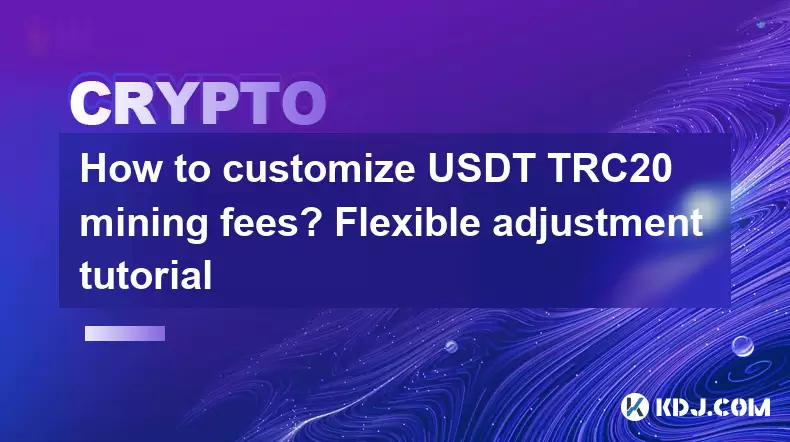
How to customize USDT TRC20 mining fees? Flexible adjustment tutorial
Jun 13,2025 at 01:42am
Understanding USDT TRC20 Mining FeesMining fees on the TRON (TRC20) network are essential for processing transactions. Unlike Bitcoin or Ethereum, where miners directly validate transactions, TRON uses a delegated proof-of-stake (DPoS) mechanism. However, users still need to pay bandwidth and energy fees, which are collectively referred to as 'mining fe...
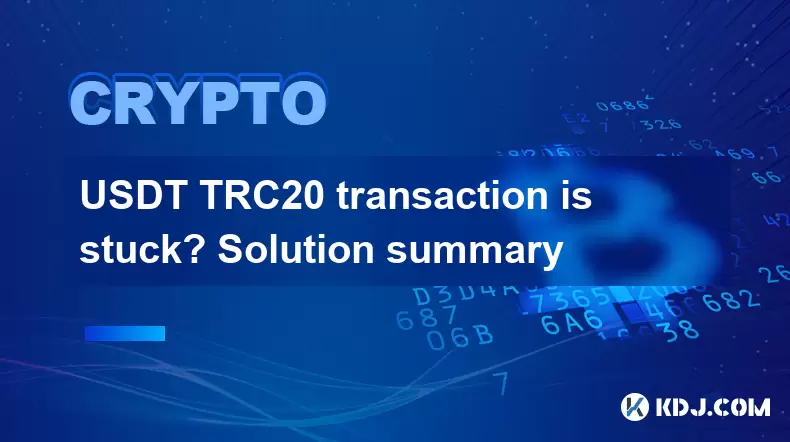
USDT TRC20 transaction is stuck? Solution summary
Jun 14,2025 at 11:15pm
Understanding USDT TRC20 TransactionsWhen users mention that a USDT TRC20 transaction is stuck, they typically refer to a situation where the transfer of Tether (USDT) on the TRON blockchain has not been confirmed for an extended period. This issue may arise due to various reasons such as network congestion, insufficient transaction fees, or wallet-rela...
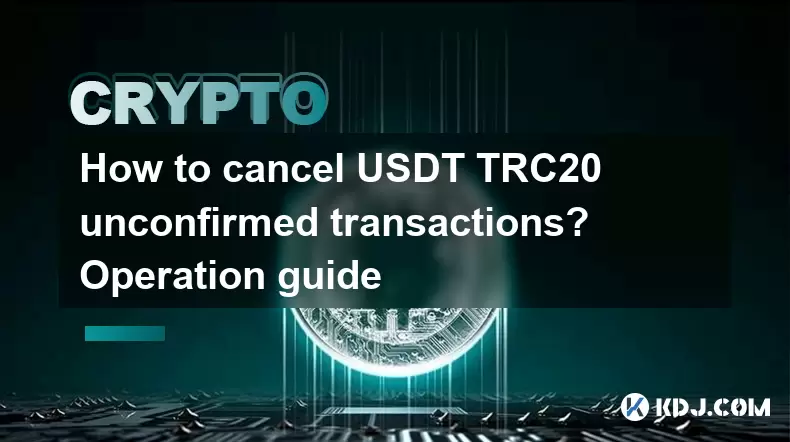
How to cancel USDT TRC20 unconfirmed transactions? Operation guide
Jun 13,2025 at 11:01pm
Understanding USDT TRC20 Unconfirmed TransactionsWhen dealing with USDT TRC20 transactions, it’s crucial to understand what an unconfirmed transaction means. An unconfirmed transaction is one that has been broadcasted to the blockchain network but hasn’t yet been included in a block. This typically occurs due to low transaction fees or network congestio...
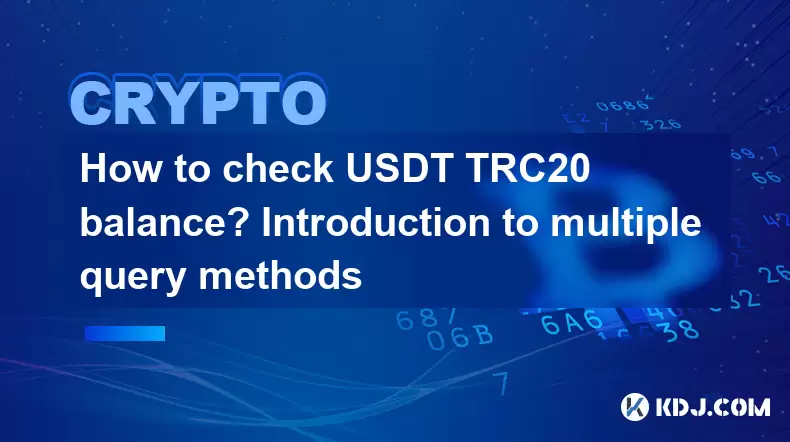
How to check USDT TRC20 balance? Introduction to multiple query methods
Jun 21,2025 at 02:42am
Understanding USDT TRC20 and Its ImportanceUSDT (Tether) is one of the most widely used stablecoins in the cryptocurrency market. It exists on multiple blockchain networks, including TRC20, which operates on the Tron (TRX) network. Checking your USDT TRC20 balance accurately is crucial for users who hold or transact with this asset. Whether you're sendi...
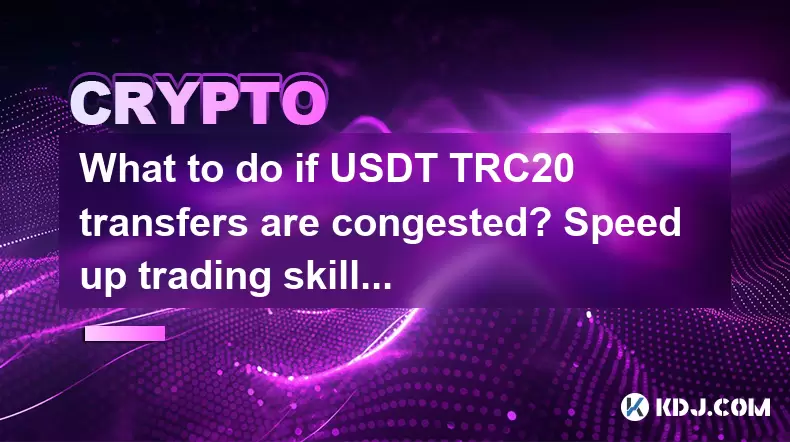
What to do if USDT TRC20 transfers are congested? Speed up trading skills
Jun 13,2025 at 09:56am
Understanding USDT TRC20 Transfer CongestionWhen transferring USDT TRC20, users may occasionally experience delays or congestion. This typically occurs due to network overload on the TRON blockchain, which hosts the TRC20 version of Tether. Unlike the ERC20 variant (which runs on Ethereum), TRC20 transactions are generally faster and cheaper, but during...
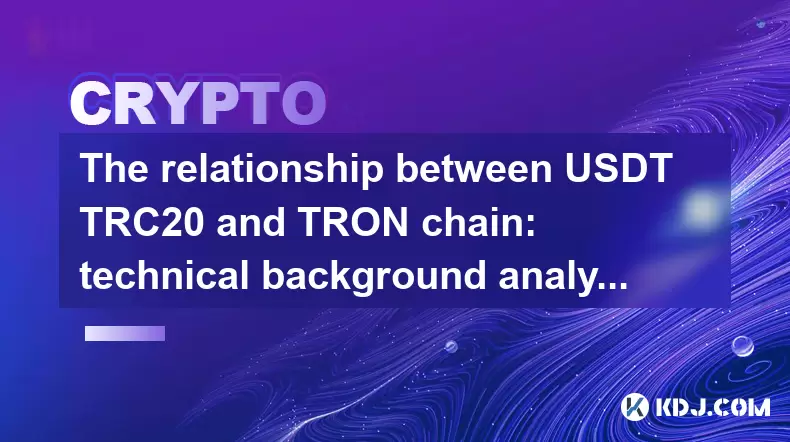
The relationship between USDT TRC20 and TRON chain: technical background analysis
Jun 12,2025 at 01:28pm
What is USDT TRC20?USDT TRC20 refers to the Tether (USDT) token issued on the TRON blockchain using the TRC-20 standard. Unlike the more commonly known ERC-20 version of USDT (which runs on Ethereum), the TRC-20 variant leverages the TRON network's infrastructure for faster and cheaper transactions. The emergence of this version came as part of Tether’s...

How to customize USDT TRC20 mining fees? Flexible adjustment tutorial
Jun 13,2025 at 01:42am
Understanding USDT TRC20 Mining FeesMining fees on the TRON (TRC20) network are essential for processing transactions. Unlike Bitcoin or Ethereum, where miners directly validate transactions, TRON uses a delegated proof-of-stake (DPoS) mechanism. However, users still need to pay bandwidth and energy fees, which are collectively referred to as 'mining fe...

USDT TRC20 transaction is stuck? Solution summary
Jun 14,2025 at 11:15pm
Understanding USDT TRC20 TransactionsWhen users mention that a USDT TRC20 transaction is stuck, they typically refer to a situation where the transfer of Tether (USDT) on the TRON blockchain has not been confirmed for an extended period. This issue may arise due to various reasons such as network congestion, insufficient transaction fees, or wallet-rela...

How to cancel USDT TRC20 unconfirmed transactions? Operation guide
Jun 13,2025 at 11:01pm
Understanding USDT TRC20 Unconfirmed TransactionsWhen dealing with USDT TRC20 transactions, it’s crucial to understand what an unconfirmed transaction means. An unconfirmed transaction is one that has been broadcasted to the blockchain network but hasn’t yet been included in a block. This typically occurs due to low transaction fees or network congestio...

How to check USDT TRC20 balance? Introduction to multiple query methods
Jun 21,2025 at 02:42am
Understanding USDT TRC20 and Its ImportanceUSDT (Tether) is one of the most widely used stablecoins in the cryptocurrency market. It exists on multiple blockchain networks, including TRC20, which operates on the Tron (TRX) network. Checking your USDT TRC20 balance accurately is crucial for users who hold or transact with this asset. Whether you're sendi...

What to do if USDT TRC20 transfers are congested? Speed up trading skills
Jun 13,2025 at 09:56am
Understanding USDT TRC20 Transfer CongestionWhen transferring USDT TRC20, users may occasionally experience delays or congestion. This typically occurs due to network overload on the TRON blockchain, which hosts the TRC20 version of Tether. Unlike the ERC20 variant (which runs on Ethereum), TRC20 transactions are generally faster and cheaper, but during...

The relationship between USDT TRC20 and TRON chain: technical background analysis
Jun 12,2025 at 01:28pm
What is USDT TRC20?USDT TRC20 refers to the Tether (USDT) token issued on the TRON blockchain using the TRC-20 standard. Unlike the more commonly known ERC-20 version of USDT (which runs on Ethereum), the TRC-20 variant leverages the TRON network's infrastructure for faster and cheaper transactions. The emergence of this version came as part of Tether’s...
See all articles























